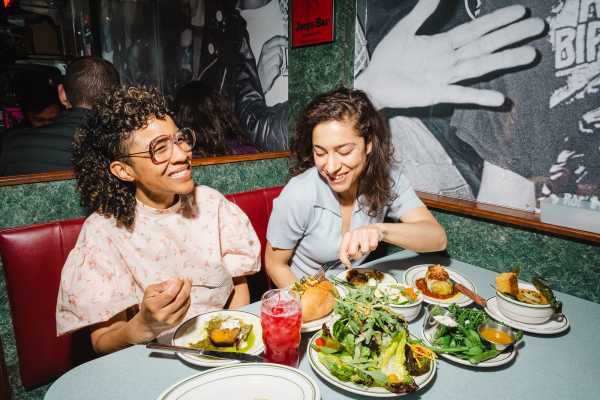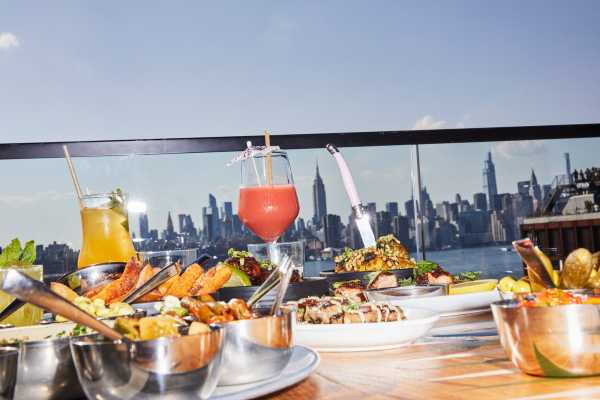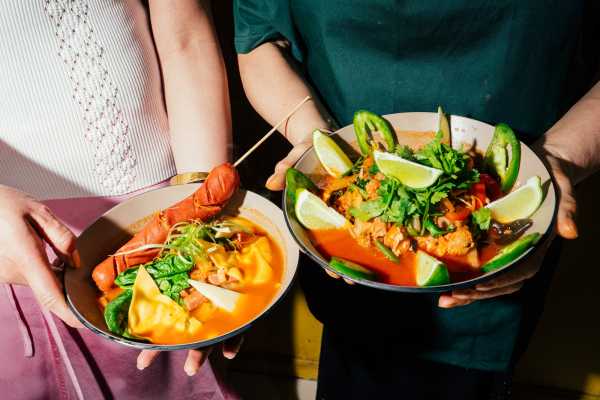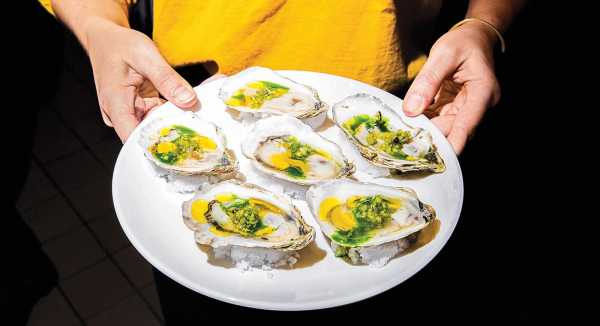
Save this storySave this storySave this storySave this story
You could write dozens of obituaries a year for beloved New York restaurants that have shuttered their doors. One of the things I love most about this city is how regenerative it is, against all odds. We’re living at a moment when it’s harder than ever to keep a restaurant running, let alone open a new one, yet there are always, improbably, new places to eat—global pandemics and floodwaters be damned. In the past few years, as I ate my way through the boroughs, chronicling meals for Tables for Two, the delights seemed inexhaustible. I recently transitioned to a new role, which means I’m no longer writing the column every week (though I will still be writing regularly about food for the magazine). As a parting gift to readers, I decided to make a list of my favorite places that I’ve reviewed. It’s s hard to pick, but I’ve found a few thrills to be especially electric. An ancient Jewish lunch counter in the Flatiron district, brought lovingly back to life by new owners and made somehow more essentially itself. A palace of traditional Turkish food in a former pancake house on Staten Island, worth a trip across the Verrazzano Bridge in standstill traffic. A tiny noodle stall buried deep inside a food hall in Koreatown, run by a devoted daughter and her mother, who has a hand in making every plate of food. The best cocktails I’ve ever had—laced with orange-blossom water and dried lime—at a Persian restaurant in Bushwick. Here are twenty New York restaurants, among thousands, that I recommend without reservation.


Photograph by Lanna Apisukh for The New YorkerSuperiority Burger
Vegetarian | East Village
Earlier this year, the chef Brooks Headley relocated his previously tiny veggie-burger joint to the relatively sprawling space in the East Village that, for decades, had housed the Odessa Restaurant. The original Superiority Burger offered just six dishes, plus specials and desserts. All of it, including the eponymous burger, was vegetarian; a lot was “accidentally vegan.” Everything popped. On recent visits, I was delighted to find that Headley is keeping the focus as tight as ever. New additions are few but powerful. In a nod to Odessa’s Ukrainian heritage, there’s a texturally thrilling stuffed cabbage, filled with sticky rice and oyster and button mushrooms, draped in a sweet-and-sour tomato sauce, and finished with crunchy focaccia bread crumbs. Holdovers from the old menu include the burger, made from quinoa, chickpeas, and walnuts; the Sloppy Dave (tofu chili, frizzled onions); the burnt-broccoli salad (eggplant purée, candied cashews); and the beets with cream cheese and pretzels—all still wonderful. Read the full review »

Photograph by Jeremy Liebman for The New YorkerLaser Wolf
Israeli | Williamsburg
On a summer evening at Laser Wolf, a restaurant on the rooftop of the Hoxton hotel, in Williamsburg, a friendly but authoritative woman zipped dutifully from table to table, pausing at each. “We clap for the sunset,” she announced. “Don’t panic.” For a moment, service seemed to halt. Bodies shifted westward as the collective gaze settled on an unimpeded view of the Manhattan skyline. Phones were drawn. As the gleaming orb sank behind the Con Ed clock tower, blue sky melting into gold, dramatic rays backlighting cotton-ball clouds, applause went up, accompanied by cheers. With a vista like this, food and drink could easily be secondary, not to mention a total ripoff. At Laser Wolf—an outpost of the beloved Philadelphia restaurant of the same name, from the Israeli American chef Michael Solomonov and the restaurateur Steve Cook—it’s the setting that feels negligible. Read the full review »

Photograph by Tonje Thilesen for The New YorkerGreat N.Y. Noodletown
Cantonese | Chinatown
The intensely beloved Cantonese restaurant closed for several months in 2022; when the metal gates were finally raised again, last September: rejoicement. The food was as good as—if not better than—anyone remembered. I’d last been there in 2017, when the lo mein with ginger and scallion, a slippery mass of thin, curly noodles, activated taste buds on the back of my tongue that I wouldn’t otherwise know were there. What a pleasure it was to be reunited with that sensation, and to be served a bowl of clear, fragrant broth dense with wontons bobbing like jellyfish, their ruffled bellies stuffed tightly with shrimp, their slippery wrappers trailing like tentacles. Among old favorites I found new ones: thick e-fu noodles strewn over a lobster chopped in its shell; a ceramic crock overflowing with clams, steamed in rice wine with great hunks of ginger and scallion, piled atop glass noodles. Read the full review »

Photograph by Ina Jang for The New YorkerJu Qi
Beijing Chinese | Flushing
The most obvious thing to eat at Ju Qi, a restaurant in Tangram, a luxury mall in Flushing, is a bird—a whole Peking duck, carved tableside. First, a chef with the precision of a surgeon removes a long strip of lacquered, golden skin, which gets razored into segments the size of postage stamps; each is placed atop a square of steamed bread and finished with a delicate pile of sturgeon caviar. From what looks like a royal jewel chest, a server pulls tiny drawers housing accoutrements—hoisin, scallions, matchsticks of cucumber, pickles, honeydew melon—then demonstrates the optimal technique for wrapping slices of meat and garnishes into bing pancakes, plucked from a bamboo steamer. It’s a thrillingly theatrical experience, with a grand finale: Do you want the carcass hacked into bite-size pieces and crisp-fried, or submerged in a fragrant and savory cloudy soup, with silken tofu and tender greens? I preferred the latter, but both preparations do justice to the precious bits of meat and fat which cling to the bones. Read the full review »

Photograph by Yael Malka for The New YorkerZara Forest Grill
Turkish | Staten Island
Even in the best circumstances, a trip to Staten Island from any other borough is a commitment, a decent journey by bridge or boat. For Zara Forest Grill, in Graniteville, which is closer to New Jersey than Manhattan, it’s a commitment I’m willing to make. For breakfast, there is gozleme, a flaky flatbread folded around potato, spinach and cheese, or ground meat, and menemen, a curdy scramble of eggs, tomatoes, and peppers. Lunch and dinner are best begun with the balon bread, a shiny blimp speckled in sesame seeds which exhales a gust of hot air when you tear off an end, to swipe through meze, such as a luscious labneh hiding crunchy walnuts in its depths, or aci ezme, a coarse and spicy mix of bell peppers, tomatoes, cucumbers, walnuts, parsley, and chili flakes. Standouts among the entrées include the Iskender kebab: glistening shavings of perfectly seasoned lamb gyro are dressed in tomato sauce, piled atop silky yet crispy nubs of “butter-roasted bread,” and served with tangy yogurt. Read the full review »


Photograph by Jutharat Pinyodoonyachet for The New YorkerThai Diner
Thai | Nolita
The menu at this Nolita restaurant, owned by Ann Redding and her husband, Matt Danzer, is partly inspired by the way that Redding’s mother, who emigrated from Thailand, adapted her cooking to the U.S. The Thai disco fries come smothered in massaman curry, red onions, peanuts, and coconut cream; breakfast offerings include spectacular egg sandwiches made with roti snugly folded around a soft scramble, American cheese, Thai basil, and either sai oua—a Northern Thai-style curry-seasoned pork sausage—or avocado and bok choy. Some of the dishes here have been, happily, transplanted from Uncle Boons, the couple’s first, more strictly Thai restaurant, which they were forced to close in 2020. I was especially glad to be reunited with the superlative phat Thai (a.k.a. pad Thai), and with a cut-crystal coupe of finely minced peanuts, dried shrimp, raw onion, and ginger, to be wrapped with toasted-coconut sauce in peppery betel leaves. Read the full review »

Photograph by Rana Duzyol for The New Yorkergertrude’s
Jewish American | Prospect Heights
The restaurateurs behind gertrude’s, a bistro in Prospect Heights, pulled inspiration from New York institutions such as Prune, Diner, and Minetta Tavern, as well as from their own backgrounds. “We talked about a menu that, if you had grown up eating specific dishes at your grandparents’ house on specific Jewish holidays, would seem really nostalgic and familiar to you,” Eli Sussman, one of the owners, said. “And, conversely, would be appealing even if you had no interest in Jewish cuisine.” The result transcends expectations you might have for a neighborhood restaurant while also resisting gimmickry. The half chicken is brined, cleverly, in dill-pickle juice before it’s roasted. The excellent hamburger is sandwiched on a tall, shiny braided challah roll, which can also be ordered on its own, with a schmear of duck butter. All entrées, including a beautiful whole trout—stuffed with lemon rounds and showered with chopped green olives and herbs—come with a choice of fries, greens, or latkes. Read the full review »

Photograph by Jutharat Pinyodoonyachet for The New YorkerNoona Noodles
Korean | Koreatown
I can think of no better summer meal than a bowl of naengmyeon, a cold Korean noodle soup traditionally eaten after a meal of barbecue. Noona Noodles, a stall run by a mother-daughter duo in a food court in Manhattan’s Koreatown, offers two varieties: mul and bibim, rebranded as Icy and Icy Spicy. Both feature an intensely flavorful broth, made by boiling brisket with fresh pineapple, Asian pear, apple, lemon, daikon, and assorted alliums, and are finished with big hunks of slushy ice, which soak up the sweet, sour, savory liquid like snow cones. In the center of each bowl is a pile of skinny, chewy, glassy noodles, plus lightly pickled daikon, cucumber, and a couple slices of brisket. The Icy Spicy also includes a thick layer of gochujang, to be stirred in; the Icy, which contains more broth, comes with pink vinegar (left over from pickling radishes) and hot mustard, for adding a subtler kick. Read the full review »

Photograph by Cole Wilson for The New YorkerS&P Lunch
Diner | Flatiron
Eric Finkelstein and Matt Ross, the sandwich experts and playful nostalgists behind Court Street Grocers and the HiHi Room, have taken over the restaurant formerly known as Eisenberg’s, a Jewish-style lunch counter near the Flatiron Building, and proved themselves to be gifted preservationists as well as savvy restaurateurs. The menu has been pared down, but it still feels encyclopedic in the tradition of a short-order diner, featuring roughly three dozen sandwiches, including hamburgers. The classics have not been updated so much as painstakingly honed. “It’s like, in your brain, when you eat something, what you want it to taste like,” Ross told me. “That’s our goal.” Some of my happiest moments of late have been spent marvelling at the glory of dishes I’d taken for granted: a ripe half cantaloupe filled with cottage cheese, a bowl of iceberg lettuce topped with egg salad, cream cheese and chopped green olives (a surprisingly thrilling combination) on squishy white bread. Read the full review »

Photograph by Tonje Thilesen for The New YorkerErnesto’s
Basque | Lower East Side
If anyone objects to the union of two types of anchovies in the pintxo matrimonio al ajillo at Ernesto’s, a Basque-leaning restaurant on the Lower East Side, speak now and I will eat yours for you. The matrimony of a boqueron (plump, meaty, and white, pickled in wine vinegar and olive oil) and an anchoa (a dark, skinny, salt-cured umami bomb) is holy indeed, made holier by the kitchen’s decision to mount the pair, like prostrate wedding-cake toppers, on a rectangle of delicately crisp, buttery pastry. Though the fillets are separated by a neat line of ajillo, a zingy condiment of parsley and garlic, each bite brings them together in perfect harmony. Read the full review »


Photograph by Heami Lee for The New YorkerDhamaka
Indian | Lower East Side
At Dhamaka, an Indian restaurant in Essex Market, on the Lower East Side, my dining companions and I took turns dragging our spoons through a hot metal pot of gurda kapoora, searching for offal. Which morsels, we wondered, were the goat kidneys and which were the goat testicles? The one male in our group joked that, as the only person among us in possession of both organs, he was uniquely qualified to tell. He had eaten a lot of kidney as a child in Russia, and recognized it to be the firmer of the two organs—it was almost bouncy in texture, with a pronounced flavor that bloomed slowly and grew funkier. I preferred the testicle, meaty but mild, as supple as sweetbread, nearly spreadable. The vehicle for both was an outstanding gravy—built from a base of gelatinous lamb-trotter stock, fragrant and fiery with whole cardamom pods and green chilies, thick with melted tomato—to be spooned atop buttery, griddled halves of pao, a fluffy slider-size roll introduced to India during the Portuguese occupation of Goa. Read the full review »

Photograph by Jeremy Liebman for The New YorkerMitica
Mexican | Greenpoint
The menu at Mitica, an unassuming Mexican restaurant in Greenpoint, is small enough that I ate through it in just two visits, and found nary a misstep. The guacamole is as unexpectedly, beguilingly luscious as the version at Atla, the upscale NoHo cantina, where one of Mitica’s chefs, Edgar Gonzalez, once worked. Meanwhile, fresh tortillas, still steaming, make for an embarrassment of riches when served with a perfectly cooked fillet of steelhead trout (topped with aioli, smoked and fresh fennel, crispy potatoes, and serrano chili) and with a beautiful rib eye, charred, carved into rosy slices, and finished with a sweet-and-sour pasilla-chili demi-glace, melty whole spring onions, and greens that have wilted in the heat of the meat. Read the full review »

Photograph by Heami Lee for The New YorkerGolden Diner
Diner | Lower East Side
Golden Diner, a Lower East Side greasy spoon that opened in 2019, is not a trendy restaurant posturing as a diner for the sake of nostalgia. It’s a genuine catchall, in the mode of its forebears, but better. The matzo-ball soup is plainly excellent, no bells or whistles. Two eggs are indeed served, as the menu promises, “How you want ’em,” scrambled, fried, or folded into an omelette, and plated with a superlative crackly edged hash-brown patty rough-chopped into bite-size pieces. Just like at your local Athenian, you can order half a grapefruit; a side of bacon; a Diet Coke. Coffee refills are free. Unlike your local Athenian, Golden Diner tops its enormous, fluffy pancakes with salted honey-maple butter instead of syrup, in homage to a popular South Korean potato-chip flavor. Its chef, the Momofuku Ko alum Samuel Yoo, is Korean American and grew up in Bayside, Queens. Like a formal poet, he finds creativity within constraints, telling an enchantingly personal story without ever quite coloring outside the lines. Read the full review »

Photograph by Kyoko Hamada for The New YorkerBonnie’s
Cantonese | Williamsburg
At Bonnie’s, a Cantonese restaurant in Williamsburg, the poached half chicken, Bak Cheet Gai, comes with teacups of Gai Tong, or chicken broth, redolent of ginger and white pepper. “Sip it as you eat or dunk it to take away the chill,” my server suggested. “I love this liquid!” my dining companion announced as she sipped. I loved this liquid, too; on another evening I ordered a whole teapot of it. I used it as a palate cleanser between bites of long beans—delightfully sweet and shrivelled, positively clanging with garlic, and topped with croutons made from a kind of savory cruller often served with congee—and bites of scorching-hot Cheung Fun, seared rolled rice noodles that were sticky on the outside and custardy within, the concentrated fishiness of XO sauce (from dried scallops and shrimp) punctuated by notes of fennel seed. Read the full review »

Photograph by Kyoko Hamada for The New YorkerJalsa
Indian | Flatbush
“I’m a chaat person,” Nowshin Ali explained, when we talked over FaceTime at the beginning of the pandemic. We were discussing the menu at Jalsa Grill & Gravy, the restaurant she co-owns with her business partner, Anurag Shrivastava, in Brooklyn’s Little Pakistan, south of Prospect Park. Chaats, a signature dish of Lucknow, Ali’s home town, are defined on Jalsa’s menu as well as I’ve ever seen: “crispy-crunchy-spicy-tangy Indian snacks.” In India, they’re often sold on the street; in the U.S., they’re treated like appetizers. Was I a chaat person before I tried Jalsa’s iterations? I’d always enjoyed them, but I don’t remember ever crowing in pleasure the way I did after taking a bite of Shrivastava’s palak chaat: a pile of spinach—lightly battered in chickpea flour, warm yet nearly raw, bright green and refreshing—tossed with glossy tamarind sauce, house-made chaat masala, crispy shards of lentil noodle, onion, tomato, and cilantro. Read the full review »


Photograph by Zachary Zavislak for The New YorkerTatiana
Afro-Caribbean | Lincoln Square
In recent years, the fairly staid and hallowed institution of Lincoln Center has done its best to evolve. Tatiana, Kwame Onwuachi’s restaurant in the reopened David Geffen Hall, is a triumph in staying relevant while fitting into the broad category of performing arts: all restaurants are theatrical, of course, but eating here is like watching Onwuachi deliver a controlled and electric autobiographical monologue. The menu traces a childhood spent in the Bronx and in Nigeria and a career that began in the galley of an oil-spill-response vessel off the coast of Louisiana (his mother’s home state) before leading him to the Culinary Institute of America and then to Per Se, Eleven Madison Park, and the TV show “Top Chef.” The most obvious showpiece is the short-rib pastrami suya, a single, hefty blackened rib, seasoned at the intersection of Jewish deli and northern-Nigerian barbecue, accompanied by caraway-coconut Parker House rolls. I preferred an abundant bowl of braised oxtails, as large and beefy as I’ve ever seen, served with Thumbelina carrots, chayote squash, and rice and peas. Read the full review »

Photograph by Mengwen Cao for The New YorkerPlace des Fêtes
Wine Bar | Clinton Hill
Place des Fêtes, the name of a plaza in the Nineteenth Arrondissement of Paris, translates to “party square.” Place des Fêtes, a wine bar and restaurant in Clinton Hill, with its buttery leather stools and whitewashed brick walls, would be perfect for a first date. The kitchen—overseen by the chef and co-owner Nico Russell, known previously for Oxalis, in Crown Heights—can make magic with whatever the season, or the pantry, presents. Fingerling potatoes, grilled low and slow until their skins turned thick and crisp and separated from their velvety flesh, smacked of a campfire, except for a luscious green gloss of savory sabayon. A plate of four skinny Don Bocarte anchovy fillets in olive oil, imported from Spain, seemed austere, but proved beguilingly unctuous. My favorite of the cocktails was also the lowest A.B.V., the Vermut and Soda, which the bartender accurately described as “almost like a Dr. Pepper,” though it’s not nearly as sweet, and imparts the barest impression of smoke. Read the full review »

Photograph by David Williams for The New YorkerChez Ma Tante
European | Greenpoint
Chez Ma Tante, in Greenpoint, doesn’t bill itself as Québécois or even Canadian, but it strikes me as a restaurant made in the image of Montreal’s dining scene. Its name, which translates to “At My Aunt’s House,” comes from a beloved hot-dog stand in Montreal, and one of the two owners, the chef Aidan O’Neal, spent time cooking there and at M. Wells, a Québécois bistro in Long Island City. The short menu shifts from season to season. When I visited, the chicken-liver pâté, whipped to the consistency of butter, was as nutty and pungent as an aged cheddar. Also excellent was the kedgeree, an Anglo-Indian classic, here featuring slippery flakes of poached cod and chopped egg nestled in delicately curried rice, all topped with a tousled salad of parsley, celery, and thinly sliced sweet onion. And a French fry is a French fry until you’ve had the ones at Chez Ma Tante: enormous, creamy wedges of russet potatoes wearing crispy bronze armor that cracks easily between the teeth but holds up beautifully to thick, glassy, intensely garlicky aioli. Read the full review »

Photograph by Caroline Tompkins for The New YorkerTorrisi
Italian American | Nolita
Are we living in a Roaring Twenties redux, as was predicted when the pandemic began to wane? At the recently revived Torrisi, in Nolita’s historic Puck Building, a woman wearing a flapper headband was a bit too on the nose for my taste, but the restaurant does suggest a return to a brand of extraordinary lavishness that dissipated as the virus spread. Salt-cured ham, sliced in translucent sheets from enormous haunches displayed near the host stand, was served with a pyramid of crisp golden zeppole and pineapple mostarda. A special called Capellini Cantonese, featuring glossy angel hair tangled with garlic and jalapeño, was crowned with half of the most perfectly cooked lobster I’ve ever had. My favorite course was the most inherently excessive: dessert. The staff pushes, rightly, the affogato, a coupe layered sexily with espresso granita, vanilla ice cream, mascarpone mousse, and hot fudge. But nothing beat the “frozen yogurt”: half a grapefruit hollowed out and filled with absurdly creamy, tart soft-serve, swirled with grapefruit-Campari jam and a grassy, green olive oil, accompanied by a tiny tureen of extra jam—a marvel of both luxury and restraint. Read the full review »

Photograph by Cole Wilson for The New YorkerEyval
Persian | Bushwick
At this Persian restaurant in Bushwick, I couldn’t help but steal sips of a friend’s orange-blossom Negroni, a cold and viscous concoction that lingered on my tongue and in my memory (I can taste it now!). I’m happy to report that the dynamite drinks portended dynamite food. Eyval was opened by Ali Saboor, a former chef at Sofreh—the other best Persian restaurant in Brooklyn. Saboor’s ghormeh sabzi is a particular showstopper, a braised veal shank (don’t forget to check the bone for marrow) crowned with a crisp disk of herbed-rice tahdig and rising regally from a rich stew of tender kidney beans and melty greens and alliums, including parsley, spinach, and leeks, plus fenugreek and limoo amani (dried lime). Plucking out a puckered leathery lime and eating it whole, sticky and sour, left me feeling as lucky as if I’d found the baby in a king cake. Read the full review »

Sourse: newyorker.com







